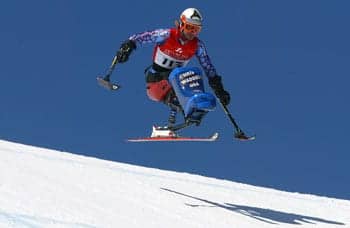
Robert M. Meehan, PT, ATP, SMS, at Frazier Rehabilitation Institute in Louisville, Ky, performs a custom seating assessment for a patient. Physical therapists, nurses, and physicians at Frazier Rehab work together to apply the latest technology to meet each patient’s unique needs.
by Robert M. Meehan, PT, ATP, SMS
Collaboration among physicians, nurses, therapists, and the full care team has always been essential in the patient journey. The complex nature of rehabilitation care means that there is no “one-size-fits-all” option. As a physical therapist, I can attest to the value of integrating knowledge, perspectives, and experience in addressing each patient and finding the right solution to meet their care needs and lifestyle. Through greater integration of specialty perspective in the clinic, along with technology and a willingness to advance, we can achieve the best possible outcomes for our patients.
Physical therapists, like myself, are specifically trained to address strength, range of motion, and postural issues, and correct biomechanical incompetence in patients. Our occupational therapist counterparts are, on the other hand, skilled with helping patients develop, recover, and improve the skills needed to complete daily living tasks such as bathing, dressing, eating, and returning to work and adapted driving. Together, physical and occupational therapists improve the physical activity and day-to-day life of patients using a wheelchair. However, as the number of wheelchair users in America continues to rise each year, it is necessary to explore additional collaboration opportunities so that we can guarantee that our patients have the highest-quality life after rehabilitation.
Custom Seating Technology
The essential purpose of custom seating technology is to increase long-term seating comfort, prevent skin breakdown, and improve postural functionality. Common trends and innovative advances in custom seating technology have made it increasingly possible for therapists to address the needs of mobility device users. With so many options, variations, technologies, and applications—many of which are outlined later in this article—it is important to have a complete picture and understanding of the patient, his or her medical needs, lifestyle, and even financial or reimbursement resources, to identify the right solution.
By working together, the experience and insight of physical and occupational therapists, combined with the medical knowledge and connections of physicians, nurses, and caregivers, clinicians can assess the seating technology options described in the following article and create the right solution for the patient.
Cushion Materials
• Gel/fluid cushion materials are being used to distribute patient weight in a gel-filled seat area, typically under the pelvis, and work by immersion and increasing overall surface contact area to prevent pressure ulcers.
• Foam cushions are convenient for therapists and mobility device users due to low maintenance and good stability. The more basic general use cushion will only have one density of foam, is usually less than 2 inches thick, and will quickly compress with full-time use. There are better skin protection and positioning cushions made from multiple densities of foam that will last longer but still have problems with compressing over time. The newest contoured foam cushions match the contour and shape of the pelvis to maximize surface contact and help to relieve pressure on bony prominences and increase air flow to decrease temperature and moisture.
• Air floatation cushions have a compartment of air cells on the seat area for seating comfort. Air volume in the latest air cushion models can be altered or adjusted to improve positioning or comfort. Alternating air cushions are an option for some, but manual wheelchair users will have to deal with an extra battery to operate the cushion.
• Hybrid cushions are composed of more than one of the cushion materials. They have become popular as the pressure-distribution components are under the pelvis, where skin breakdown is most likely. The front of the cushion is typically made of foam for increased stability during transfers and daily activities.
Positioning Equipment and Postural Supports
• Positioning components such as lateral trunk and thigh supports, headrests, straps, or belts have more adjustability to accommodate non-linear and non-symmetrical postures and improved support for the ribs with scoliosis. Dynamic materials in straps and harnesses allow greater freedom of movement and comfort for patients. Backrest shells are often made now with carbon fiber to make them lighter and adjustable, but non-removable hardware to make the wheelchairs lighter and stronger for those who self-load their wheelchairs into vehicles.
Control Systems and Power Assist
• New head arrays allow individuals to employ sensor engagement techniques to control their wheelchair with greater proportionality than previous head arrays.
• Seat elevators for power wheelchairs can now reach 10 to 12 inches of elevation to bring objects within a closer reach to patients and increase independence with transfers. Anterior tilt seating is more commonly seen and can also help with reaching, weight bearing through the legs, and stand pivot transfers.
• Mounting hardware and charging ports for electronic devices such as smart phones and tablet computers have become more prevalent, and their cost has come down. The reduced expense is helpful since many of these components are not covered by typical health insurance or Medicare.
• Applications for smart phones have been created to monitor how power wheelchair users utilize the powered seating and self-diagnose problems with the wheelchair. There are also applications for controlling and monitoring power assist for manual wheelchairs.
• Bluetooth technology is available with most complex rehabilitation power wheelchairs so users can communicate better with their phones, tablets, environmental controls, and communication devices.
• Advances in battery technology and lighter-weight materials, such as high-density plastics, have made power assist devices lighter and easier to manage for manual wheelchair users.
Pressure Mapping
• Interface pressure mapping (IPM) systems have become a more affordable method to allow patients and therapists to assess the amount of pressure present in the seating system and perform effective weight shifts via visual representation. Thanks to the new tablet-controlled pressure maps that cost thousands of dollars less than previous systems, our hospital now has them on every floor with inpatients and the outpatient seating clinic and spinal cord injury clinic. They are simple to use, and our physical and occupational therapists have been trained to use them.

Josh Carr (left), a therapy assistant, and Robert Meehan work together to fit and install mobility solutions for a patient.
A Call for Cross-Collaboration
Multidisciplinary collaboration makes it easier for patients to receive enhanced seating technology. Quite often, patients’ physician chart notes will omit mobility equipment and what assistive devices the patient needs. Consequently, it is difficult for patients to receive appropriate health insurance coverage for their mobility devices, causing them to return to their physician multiple times for new face-to-face examinations that discuss mobility needs or anything that now requires a face-to-face examination for insurance to cover needed equipment.
To eliminate this challenge, therapists and physicians should make joint evaluations that appear in chart notes or communicate to make sure there is not conflicting documentation regarding equipment needs.
In addition to physicians and manufacturers, therapists can work alongside registered nurses so that both can properly alleviate patients’ discomfort and improve patients’ posture.
Currently, patients rely on their nurses to treat ailments such as skin breakdown and therapists for posture alignment. The two specialties can work together to understand and play a role in their respective areas of expertise. An example of this would be nurses helping to train therapists about how to administer wound care modalities. Conversely, physical therapists or occupational therapists could show nurses effective positioning techniques, weight shifting techniques, and stretching or exercises to maintain posture and function.
It is important to note that relationships forged between therapists and manufacturers can help build upon advancements. When manufacturers visit inpatient rehabilitation facilities to showcase beta versions of new seating equipment, it is crucial for therapists to provide sound recommendations so that manufacturers can take their counsel into consideration during the products’ final stages of development.
A Case Study of Success
At Frazier Rehab Institute in Louisville, Kentucky, part of KentuckyOne Health, a multidisciplinary approach to patient treatment has been adopted. Once a patient is brought to the treatment facility, therapists and physicians make a concerted team assessment to accurately determine the type of wheelchair, seating system, and other equipment that a patient may need. If a patient requires further wheelchair customization, Frazier Rehab therapists ensure they communicate this information to the patient’s physician and to the assistive technology clinic. In addition, therapists and nurses work together to use technology and advanced techniques to benefit the patient, such as low-frequency ultrasound for wound treatment.
Collaboration is key to delivering the best results for our patients. This team approach and sharing of information, techniques, and technology is bringing positive results for patients at Frazier Rehab, and we see great value in the application of this approach in all rehabilitation settings. RM
Robert M. Meehan, PT, ATP, SMS, is a physical therapist at Frazier Rehabilitation Institute in Louisville, Ky. He has been a licensed PT since 2000, a certified assistive technology practitioner since 2003, and a seating and mobility specialist since 2014. He is also a T9 paraplegic and full-time manual wheelchair user. For more information, contact [email protected].







My fiancee is a T6 paraplegic in Louisville KY who has previously seen Robert Meehan for seating assessment and other things to make his wheelchair suit him best. I know that recently it has been decided that KY One will be no more and I was wondering what would happen to this wonderful service. I heard that Robert was moving on from Frazier, and we were hoping we could follow him if possible, but don’t know where that will be. Do you all have that information, or could you possibly find out? Thank you for any information you can provide.
Hello,
My fiancee is a T6 paraplegic in Louisville KY who has previously seen Robert Meehan for seating assessment and other things to make his wheelchair suit him best.
I know that recently it has been decided that KY One will be no more and I was wondering what would happen to this wonderful service. I heard that Robert was moving on from Frazier, and we were hoping we could follow him if possible, but don’t know where that will be. Do you all have that information, or could you possibly find out?
Thank you for any information you can provide.